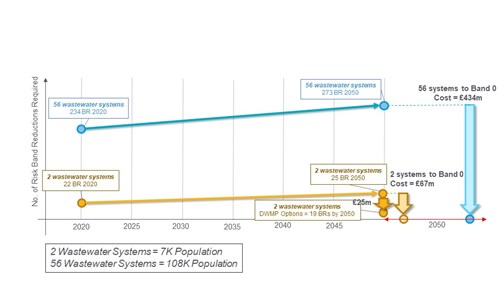Programme appraisal
The Programme Appraisal stage of the DWMP follows the Options Development and Appraisal (ODA) process. The ODA process identified the preferred options for investment in our wastewater systems to reduce the current risks as well as the risks up to 2050.
The Programme Appraisal brings the investment needs for each wastewater system together into an investment needs programme for the Rother Catchment. We look across the river basin catchment to review the investments needed, the timing of these needs and how they combine to reduce the risks to our customers and the environment.
We also look at the wider risk reduction that each option provides across all the planning objectives. Some actions, like separating rainwater from wastewater sewers, could reduce risks under several planning objectives such as storm overflows, external flooding, bathing water quality, shellfish water quality and good ecological status. The details of the method for prioritisation can be found in our Technical Summary on Programme Appraisal.
The investment needs in the Rother River Basin Catchment include
- Reducing the number of spills from the 80 storm overflows which together currently spill around 2200 times per annum
- Separating or attenuating excess rainwater in the sewer networks to reduce the risks of flooding and frequency of storm overflow discharges, especially in Hawkhurst, Wadhurst, Battle and Northiam
- Reducing nutrient discharges from the WTWs across the river basin to prevent deterioration of the internationally designated Habitats site
- A catchment wide, partnership scheme to divert surface water away from the cliffs at Fairlight
- Improving the resilience of our networks and treatment works to prevent pollution incidents, particularly in Rye and Fairlight.
Investment Needs for the river basin catchment
We progressed two wastewater systems through the ODA stage in the first cycle of the DWMP. These 4 wastewater systems serve a population of around 7,000 which is approximately 6.6% of customers in this river basin catchment.
We extrapolated the investment needs for these two systems to the other 54 systems in the Rother river basin catchment. This provides an estimate of the total investment needs required to reduce the risks in all our wastewater systems in the catchment to Band 0 (not significant). This concept of “Band Reduction” and full details of the process for extrapolation is explained in the Technical Summary on Programme Appraisal.
A graph to illustrate the extrapolation of investment needs across the whole river basin catchment is shown in figure 1.

Figure 1: Rother: Extrapolated Investment Needs and Risk Band Reduction
The programme appraisal for the Rother identified the following:
- A total of 22 band reductions are required in 2020 across the 14 Planning objectives for the two wastewater systems.
- By 2050, this will increase to 25 band reductions due to the impact of climate change, growth and creep.
- The options identified to date would cost around £25 million for the two catchments and is expected to provide 6 band reductions in 2050 (the options do not result in a Band 0 for all risks).
- The Rother has 56 catchments which require 234 band reductions in 2020 and 273 band reductions by 2050 in order to achieve band 0 across 14 planning objectives.
- Extrapolating the investment needs for all the systems in the Rother will cost around £434 million for a 108k population. This illustrates the scale of investment needed to get to band 0 by 2050.
These investment needs provide indicative costs that allow us to understand the level of funding required to reduce the risks. The funding has not been secured at this stage. The DWMP informs the development of our 5 yearly Business Plan which is submitted to our economic regulator, Ofwat, to agree how we should invest the money received from our customer bills.